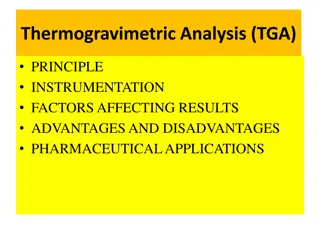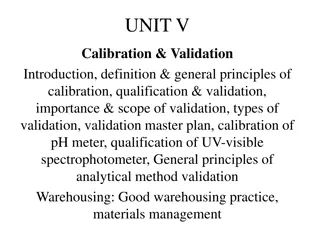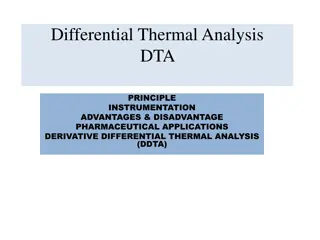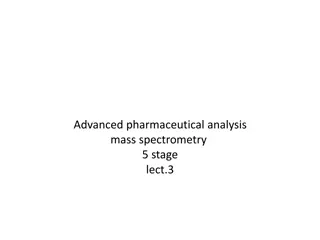Understanding Integration in Pharmaceutical Analysis
Integration in spectroscopy calculates the area under signals to determine the number of protons and their ratios in a sample. The process involves converting these values for comparison and arriving at whole numbers to represent proton counts accurately. Molecular formulas help in identifying the exact number of protons in unknown compounds for precise analysis.
Download Presentation

Please find below an Image/Link to download the presentation.
The content on the website is provided AS IS for your information and personal use only. It may not be sold, licensed, or shared on other websites without obtaining consent from the author. Download presentation by click this link. If you encounter any issues during the download, it is possible that the publisher has removed the file from their server.
E N D
Presentation Transcript
Advanced Pharmaceutical Analysis Introduction to Spectroscopy Dr. Mohammed Al Amiedy
Integration It is the area under each signal This value indicates the number of protons giving rise to the signal. After acquiring a spectrum, the computer calculates the area under each signal and then displays this area as a numerical value placed either above or below the signal. These numbers only have meaning when compared to each other.
Integration In order to convert these numbers into useful information, choose the smallest number (27.0 in this case) and then divide all integration values by this number: These numbers provide the relative number, or ratio, of protons giving rise to each signal. This means that a signal with an integration of 1.5 involves one and a half times as many protons as a signal with an integration of 1
Integration In order to arrive at whole numbers (there is no such thing as half a proton), multiply all the numbers by 2, giving the same ratio now expressed in whole numbers, 2 : 3 : 2 : 3. In other words, the signal at 2.4 ppm represents two equivalent protons, and the signal at 2.1 ppm represents three equivalent protons. Integration is often represented by step curves The height of each step curve represents the area under the signal. In this case, a comparison of the heights of the four step curves reveals a ratio of 2 : 3 : 2 : 3.
Integration When interpreting integration values, don t forget that the numbers are only relative. To illustrate this point, consider the structure of tert-butyl methyl ether (MTBE). MTBE has two kinds of protons (the methyl group and the tert-butyl group) and will produce two signals in its 1H NMR spectrum. The computer analyzes the area under each signal and gives numbers that allow us to calculate a ratio of 1 : 3
Integration This ratio only indicates the relative number of protons giving rise to each signal, not the exact number of protons. In this case, the exact numbers are 3 (for the methyl group) and 9 (for the tert-butyl group). When analyzing the NMR spectrum of an unknown compound, the molecular formula provides extremely useful information because it enables us to determine the exact number of protons giving rise to each signal. If we were analyzing the spectrum of MTBE, the molecular formula (C5H12O) would indicate that the compound has a total of 12 protons.
Integration This information then allows us to determine that the ratio of 1 : 3 must correspond with 3 protons and 9 protons, in order to give a total of 12 protons. When analyzing an NMR spectrum of an unknown compound, we must also consider the impact of symmetry on integration values. For example, consider the structure of 3-pentanone. This compound has only two kinds of protons, because the methylene groups are equivalent to each other, and the methyl groups are equivalent to each other.
Integration The 1H NMR spectrum is therefore expected to exhibit only two signals.
Integration Compare the relative integration values: 32.5 and 48.0. These values give a ratio of 2 : 3, but again the values 2 and 3 are just relative numbers. They actually represent 4 protons and 6 protons. This can be determined by inspecting the molecular formula (C5H10O), which indicates a total of 10 protons in the compound. Since the ratio of protons is 2 : 3, this ratio must represent 4 and 6 protons, respectively, in order for the total number of protons to be 10. This analysis indicates that the molecule possesses symmetry.
Multiplicity Coupling The third, and final, characteristic of each signal is its multiplicity, which is defined by the number of peaks in the signal. A singlet has one peak, a doublet has two peaks, a triplet has three peaks, a quartet has four peaks, a quintet has five peaks, and so on. A signal s multiplicity is the result of the magnetic effects of neighboring protons and therefore indicates the number of neighboring protons.
Multiplicity If Ha and Hb are not equivalent to each other, they will produce different signals. Let s focus on the signal produced by Ha. We have already seen a variety of factors that will affect the chemical shift of Ha, including inductive effects and diamagnetic anisotropy effects. All of these effects modify the magnetic field felt by Ha, thereby affecting the resonance frequency of Ha.
Multiplicity The chemical shift of Ha is also impacted by the presence of Hb, because Hb has a magnetic moment that can either be aligned with or against the external magnetic field. Hb is like a tiny magnet, and the chemical shift of Ha is dependent on the alignment of this tiny magnet. In some molecules, Hb will be aligned with the field, while in other molecules, Hb will be aligned against the field. As a result, the chemical shift of Ha in some molecules will be slightly different than the chemical shift of Ha in other molecules, resulting in the appearance of two peaks.
Multiplicity Ha has the same effect on the signal of Hb, splitting the signal for Hb into a doublet. This phenomenon is called spin-spin splitting, or coupling.
Multiplicity The chemical shift of Ha is impacted by the presence of both Hb protons, each of which can be aligned either with or against the external field. Once again, each Hb is like a tiny magnet and has an impact on the chemical shift of Ha. In each molecule, Ha can find itself in one of three possible electronic environments, resulting in a triplet. If each peak of the triplet is separately integrated, a ratio of 1 : 2 : 1 is observed, consistent with statistical expectations.
Multiplicity The chemical shift of Ha is impacted by the presence of all three Hb protons, each of which can be aligned either with the field or against the field. Each Hb is like a tiny magnet and has an impact on the chemical shift of Ha. In each molecule, Ha can find itself in one of four possible electronic environments, resulting in a quartet. If each peak of the quartet is integrated separately, a ratio of 1 : 3 : 3 : 1 is observed, consistent with statistical expectations.
Multiplicity The table below summarizes the splitting patterns and peak intensities for signals that result from coupling with neighboring protons. A pattern emerges when analyzing this information. Specifically, if n is the number of neighboring protons, then the multiplicity will be n + 1. Extending this rule, a proton with six neighbors (n = 6) will be split into a septet (7 peaks, or n + 1). This observation, called the n + 1 rule, only applies when all of the neighboring protons are chemically equivalent to each other.
Multiplicity There are two major factors that determine whether or not splitting occurs: Equivalent protons do not split each other. Consider the two methylene groups in 1,2-dichloroethane. All four protons are chemically equivalent, and therefore, they do not split each other. In order for splitting to occur, the neighboring protons must be different than the protons producing the signal.
Multiplicity Splitting is most commonly observed when protons are separated by either two or three bonds, that is, when the protons are either diastereotopic protons on the same carbon atom (geminal) or connected to adjacent carbon atoms (vicinal). When two protons are separated by more than three bonds, splitting is generally not observed.
Multiplicity When signal splitting occurs, the distance between the individual peaks of a signal is called the coupling constant, or J value, and is measured in hertz. Neighboring protons always split each other with equivalent J values. For example, consider the two kinds of protons in an ethyl group. The Ha signal is split into a quartet under the influence of its three neighbors, while the Hb signal is split into a triplet under the influence of its two neighbors.
Multiplicity Ha and Hb are said to be coupled to each other. The coupling constant Jab is the same in both signals. J values can range anywhere from 0 to 20 Hz, depending on the type of protons involved, and are independent of the operating frequency of the spectrometer. For example, if Jab is measured to be 7.3 Hz on one spectrometer, the value does not change when the spectrum is acquired on a different spectrometer that uses a stronger magnetic field.
Multiplicity As a result, NMR spectrometers with higher operating frequencies produce spectra in which different signals are less likely to overlap. As an example, compare the two spectra of ethyl chloroacetate in the figure below
Multiplicity The first spectrum was acquired on a 60-MHz NMR spectrometer, and the second spectrum was acquired on a 300- MHz NMR spectrometer. In each spectrum, the coupling constant (Jab) is approximately 7 Hz. The coupling constant only appears to be larger in the 60-MHz 1H NMR spectrum, because each ppm corresponds with 60Hz. The distance between each peak (7 Hz) is more than 10% of a ppm
Multiplicity In contrast, the coupling constant appears much smaller in the 300-MHz 1H NMR spectrum, because each ppm corresponds with 300 Hz, and as a result, the distance between each peak (7 Hz) is only 2% of a ppm. This example illustrates why spectrometers with higher operating frequencies avoid overlapping signals. For this reason, 60-MHz NMR spectrometers are rarely used for routine research. They have been widely replaced with 300- and 500-MHz instruments.























